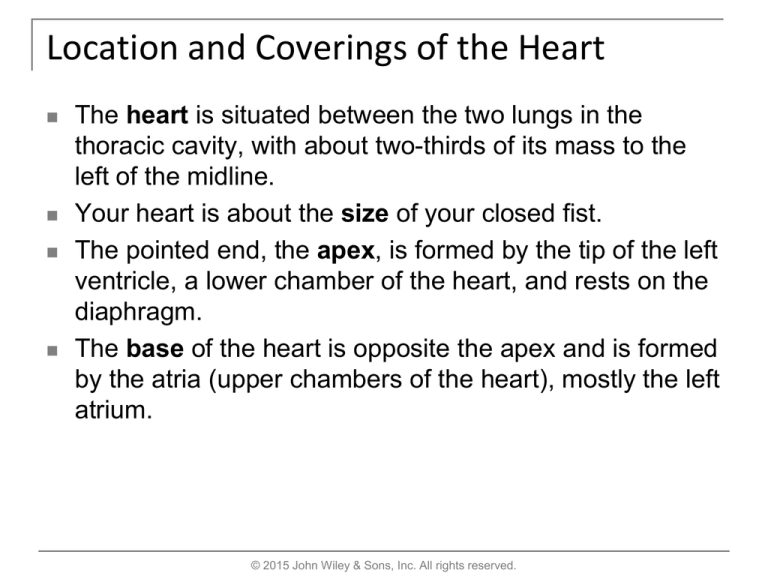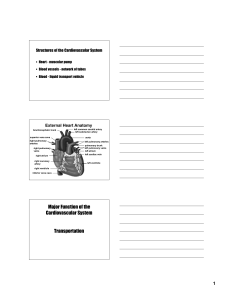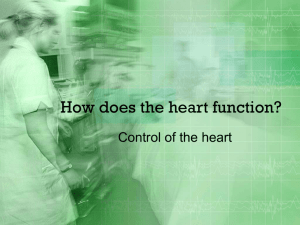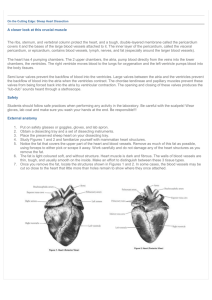
Location and Coverings of the Heart
The heart is situated between the two lungs in the
thoracic cavity, with about two-thirds of its mass to the
left of the midline.
Your heart is about the size of your closed fist.
The pointed end, the apex, is formed by the tip of the left
ventricle, a lower chamber of the heart, and rests on the
diaphragm.
The base of the heart is opposite the apex and is formed
by the atria (upper chambers of the heart), mostly the left
atrium.
© 2015 John Wiley & Sons, Inc. All rights reserved.
Pericardium
The membrane that surrounds and protects the heart and holds it in place is
the pericardium (peri- = around).
It consists of two parts: the fibrous pericardium and the serous
pericardium.
The outer fibrous pericardium is a tough, inelastic, dense irregular
connective tissue layer. It prevents overstretching of the heart, provides
protection, and anchors the heart in place.
The inner serous pericardium is a thinner, more delicate membrane that
forms a double layer around the heart.
The outer parietal layer of the serous pericardium is fused to the fibrous
pericardium.
The inner visceral layer of the serous pericardium, also called the
epicardium (epi- = on top of), adheres tightly to the surface of the heart.
© 2015 John Wiley & Sons, Inc. All rights reserved.
Heart Wall
The wall of the heart has three layers: epicardium, myocardium, and
endocardium.
Epicardium (external layer) - is also known as the visceral layer of serous
pericardium, is the thin, transparent outer layer of the wall.
It is composed of mesothelium and connective tissue.
Myocardium (middle layer) - consists of cardiac muscle tissue (myo- =
muscle), which constitutes the bulk of the heart.
Cardiac muscle fibers (cells) are involuntary, striated, and branched, and
the tissue is arranged in interlacing bundles of fibers.
Cardiac muscle fibers form two separate networks—one atrial and one
ventricular.
Each cardiac muscle fiber connects with other fibers in the networks by
thickenings of the sarcolemma (plasma membrane) called intercalated
discs. Within the discs are gap junctions that allow action potentials to
conduct from one cardiac muscle fiber to the next.
© 2015 John Wiley & Sons, Inc. All rights reserved.
Heart Wall
Endocardium (inner layer) - is a thin layer of simple squamous epithelium
that lines the inside (endo- = within) of the myocardium and covers the
valves of the heart and the tendons attached to the valves. It is continuous
with the epithelial lining of the large blood vessels.
© 2015 John Wiley & Sons, Inc. All rights reserved.
Chambers of the Heart
The heart contains four chambers:
The two upper chambers are the atria (= entry halls or chambers).
The two lower chambers are the ventricles (= little bellies).
Between the right atrium and left atrium is a thin partition called the
interatrial septum.
A prominent feature of this septum is an oval depression called the fossa
ovalis. The foramen ovale normally closes soon after birth.
An interventricular septum separates the right ventricle from the left
ventricle.
© 2015 John Wiley & Sons, Inc. All rights reserved.
Great Vessels of the Heart
The right atrium receives deoxygenated blood through three veins, blood
vessels that return blood to the heart:
The superior vena cava (vena = vein; cava = hollow, a cave) brings
blood mainly from parts of the body above the heart.
The inferior vena cava brings blood mostly from parts of the body
below the heart.
The coronary sinus drains blood from most of the vessels supplying the
wall of the heart
The right atrium then delivers the deoxygenated blood into the right
ventricle, which pumps it into the pulmonary trunk.
The pulmonary trunk divides into a right and left pulmonary artery, to the
corresponding lung.
Arteries are blood vessels that carry blood away from the heart.
Oxygenated blood enters the left atrium via four pulmonary veins.
The blood then passes into the left ventricle, which pumps the blood into
the ascending aorta.
From here the oxygenated blood is carried to all parts of the body.
© 2015 John Wiley & Sons, Inc. All rights reserved.
Valves of the Heart
To prevent the blood from flowing backward, the heart has four valves
composed of dense connective tissue covered by endothelium.
These valves open and close in response to pressure changes as the heart
contracts and relaxes.
Atrioventricular (AV) valves lie between the atria and ventricles.
The AV valve between the right atrium and right ventricle is called the
tricuspid valve because it consists of three cusps (folds or flaps).
Tendon-like cords, called chordae tendineae connect to papillary muscles
located on the inner surface of the ventricles.
The AV valve between the left atrium and left ventricle is called the bicuspid
(mitral) valve.
It has two cusps that work in the same way as the cusps of the tricuspid valve.
For blood to pass from an atrium to a ventricle, an atrioventricular valve must
open
© 2015 John Wiley & Sons, Inc. All rights reserved.
Valves of the Heart
Near the origin of the pulmonary trunk and aorta are semilunar valves called
the pulmonary valve and the aortic valve that prevent blood from flowing back into
the heart.
The pulmonary valve lies in the opening where the pulmonary trunk leaves the
right ventricle.
The aortic valve is situated at the opening between the left ventricle and the
aorta
.
Each valve consists of three semilunar (half-moon-shaped) cusps that
attach to the artery wall.
Like the atrioventricular valves, the semilunar valves permit blood to flow in
one direction only— in this case, from the ventricles into the arteries.
Each valve consists of three semilunar (half-moon-shaped) cusps that
attach to the artery wall.
Like the atrioventricular valves, the semilunar valves permit blood to flow
in one direction only— in this case, from the ventricles into the arteries.
© 2015 John Wiley & Sons, Inc. All rights reserved.
Blood Flow and Blood Supply of the Heart
Blood flows through the heart from areas of higher pressure to areas of
lower pressure. The pressure is related to the size and volume of a
chamber.
The movement of blood through the heart is controlled by the opening and
closing of the valves and the contraction and relaxation of the
myocardium.
The flow of blood through the numerous vessels in the myocardium is called
coronary (cardiac) circulation.
The principal coronary vessels are the left and right coronary arteries,
which originate as branches of the ascending aorta.
Each artery branches and then branches again to deliver oxygen and
nutrients throughout the heart muscle.
Most of the deoxygenated blood, which carries carbon dioxide and wastes,
is collected by a large vein on the posterior surface of the heart, the
coronary sinus, which empties into the right atrium.
© 2015 John Wiley & Sons, Inc. All rights reserved.
Blood Flow and Blood Supply of the Heart
The flow of blood through the numerous vessels in the myocardium is called
coronary (cardiac) circulation.
The principal coronary vessels are the left and right coronary arteries,
which originate as branches of the ascending aorta.
Each artery branches and then branches again to deliver oxygen and
nutrients throughout the heart muscle.
Most of the deoxygenated blood, which carries carbon dioxide and wastes, is
collected by a large vein on the posterior surface of the heart, the coronary
sinus, which empties into the right atrium.
© 2015 John Wiley & Sons, Inc. All rights reserved.
Conduction System of the Heart
The conduction system consists of specialized cardiac muscle tissue that
generates and distributes action potentials.
Components of this system are the sinoatrial (SA) node (pacemaker),
atrioventricular (AV) node, atrioventricular (AV) bundle (bundle of His),
bundle branches, and Purkinje fibers.
The sinoatrial (SA) node, located in the right atrial wall, begins cardiac
excitation.
This is the natural pacemaker of the heart.
The atrioventricular (AV) node, is located in the interatrial septum, just
anterior to the opening of the coronary sinus.
At the AV node, the action potential slows considerably, providing time for
the atria to empty their blood into the ventricles.
© 2015 John Wiley & Sons, Inc. All rights reserved.
Conduction System of the Heart
The sinoatrial (SA) node, located in the right atrial wall, begins cardiac
excitation.
This is the natural pacemaker of the heart.
The atrioventricular (AV) node, is located in the interatrial septum, just
anterior to the opening of the coronary sinus.
At the AV node, the action potential slows considerably, providing time for
the atria to empty their blood into the ventricles.
From the AV node, the action potential enters the atrioventricular (AV)
bundle (also known as the bundle of His), in the interventricular septum.
The AV bundle is the only site where action potentials can conduct from
the atria to the ventricles.
After conducting through the AV bundle, the action potential then enters
both the right and left bundle branches that course through the
interventricular septum toward the apex of the heart.
Finally, Purkinje fibers rapidly conduct the action potential, first to the
apex of the ventricles and then upward to the remainder of the ventricular
myocardium.
© 2015 John Wiley & Sons, Inc. All rights reserved.
Electrocardiogram
Conduction of action potentials through the heart generates electrical
currents that can be picked up by electrodes placed on the skin.
A recording of the electrical changes that accompany the heartbeat is called an
electrocardiogram, which is abbreviated as either ECG or EKG.
Three clearly recognizable waves accompany each heartbeat:
The first, called the P wave, is a small upward deflection on the ECG; it
represents atrial depolarization.
Depolarization causes contraction. Thus, a fraction of a second after the P
wave begins, the atria contract.
The second wave, called the QRS complex, begins as a downward deflection
(Q).
Then continues as a large, upright, triangular wave (R).
And ends as a downward wave (S).
The QRS complex represents the onset of ventricular depolarization, when
the ventricles start to contract.
The third wave is the T wave, a dome-shaped upward deflection that indicates
ventricular repolarization and occurs just before the ventricles start to relax.
© 2015 John Wiley & Sons, Inc. All rights reserved.
The Cardiac Cycle
A single cardiac cycle includes all of the events associated with one
heartbeat.
In a normal cardiac cycle, the two atria contract while the two ventricles relax;
then, while the two ventricles contract, the two atria relax.
The term systole refers to the phase of contraction.
Diastole refers to the phase of relaxation.
A cardiac cycle consists of systole and diastole of both atria plus systole and
diastole of both ventricles.
The cardiac cycle can be divided into three phases:
1.
Relaxation period - this begins at the end of a cardiac cycle when the
ventricles start to relax and all four chambers are in diastole.
2.
Atrial systole - contraction of atria.
3.
Ventricular systole - contraction of ventricles
Heart Sounds - the sound of the heartbeat comes primarily from the closure of
the valves.
The first sound, lubb, is a long, booming sound from the AV valves closing
after ventricular systole begins.
The second sound, a short, sharp sound, dupp, is from the semilunar valves
closing at the end of ventricular systole.
© 2015 John Wiley & Sons, Inc. All rights reserved.
Cardiac Output
The volume of blood ejected per minute from the left ventricle into the
aorta is called the cardiac output (CO).
Cardiac output is determined by (1) the stroke volume (SV), the amount of
blood ejected by the left ventricle during each beat (contraction).
(2) Heart rate (HR), the number of heartbeats per minute.
In a resting adult, stroke volume averages 70 mL, and heart rate is about
75 beats per minute.
Thus the average cardiac output in a resting adult is:
Cardiac output
= stroke volume x heart rate
= 70 mL/beat x 75 beats/min
= 5250 mL/min or 5.25 liters/min
Factors that increase stroke volume or heart rate, such as exercise,
increase cardiac output.
© 2015 John Wiley & Sons, Inc. All rights reserved.
Cardiac Output
Three factors regulate stroke volume and ensure that the left and right
ventricles pump equal volumes of blood:
1.
The degree of stretch in the heart before it contracts. The greater the
force of contraction during systole, a relationship known as the Frank–
Starling law of the heart, the more forcefully it contracts (like
stretching a rubber band) - Preload
2. The forcefulness of contraction of individual ventricular muscle
fibers. The heart can contract more or less forcefully when certain
substances are present: Stimulation of the sympathetic (ANS),
increases the force of contraction of cardiac muscle.
Inhibition of the sympathetic nervous system (ANS), decreases the
force of contraction - Contractility
3. The pressure required to eject blood from the ventricles - Afterload
Autonomic Regulation of Heart Rate - the nervous system regulation of
the heart originates in the cardiovascular (CV) center in the medulla
oblongata.
Other regulators include: the cardiac accelerator nerves, vagus (X)
nerves, baroreceptors, and chemoreceptors.
© 2015 John Wiley & Sons, Inc. All rights reserved.
Cardiac Output
Other Factors in Heart Rate Regulation - Age, gender, physical fitness,
and body temperature also influence resting heart rate.
Increased body temperature (fever or strenuous exercise) increases heart
rate by causing the SA node to discharge more rapidly. Decreased body
temperature decreases heart rate and force of contraction.
© 2015 John Wiley & Sons, Inc. All rights reserved.
Exercise and the Heart
A person’s cardiovascular fitness can be improved at any age with regular
exercise.
Aerobic exercise, any activity that works large body muscles for at least 20
minutes, elevates cardiac output and accelerates metabolic rate.
Three to five such sessions a week are usually recommended for
improving the health of the cardiovascular system.
Brisk walking, running, bicycling, cross-country skiing, and swimming are
examples of aerobic activities.
Sustained exercise increases the oxygen demand of the muscles.
Regular exercise also helps to reduce blood pressure, anxiety, and
depression; control weight; and increase the body’s ability to dissolve blood
clots.
Copyright 2015 John Wiley & Sons, Inc.
© 2015 John Wiley & Sons, Inc. All rights reserved.







